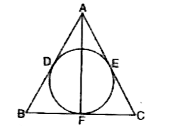ABC is isosceles triangle where AB = AC which is circumscribed about a circel. If P is the point where the circle touches the side BC, then which of the following is true?
BP=PC
BP>PC
BP<PC
1BP=12PC
To solve the problem, we need to analyze the properties of the isosceles triangle ABC, where AB = AC, and the circle that is inscribed within it. The point P is where the incircle touches the side BC.
1. Identify the Triangle and Circle:
- We have an isosceles triangle ABC with AB = AC.
- The triangle is circumscribed about a circle (incircle).
2. Label the Points:
- Let the points where the incircle touches the sides be P (on BC), Q (on CA), and R (on AB).
3. Understand Tangent Properties:
- The tangents drawn from a point outside the circle to the circle are equal in length.
- Therefore, if we denote the lengths of the tangents from point A to the points of tangency Q and R as AP=AQ and AR=AP, we can denote:
- AP=a
- BP=b
- CP=c
4. Set Up the Equations:
- Since AB = AC, we have:
- AP+BP=AB (1)
- AP+CP=AC (2)
- From (1) and (2), we can conclude that:
- a+b=a+c
5. Simplify the Equations:
- By subtracting a from both sides of the equation a+b=a+c, we get:
- b=c
6. Conclusion:
- Since b=c, this means that the lengths from point P to points B and C are equal. Therefore, the segments DP and CP are equal, which confirms that the point P divides BC into two equal segments.
Final Answer:
Thus, we can conclude that DP=CP.
- We have an isosceles triangle ABC with AB = AC.
- The triangle is circumscribed about a circle (incircle).
- Let the points where the incircle touches the sides be P (on BC), Q (on CA), and R (on AB).
- The tangents drawn from a point outside the circle to the circle are equal in length.
- Therefore, if we denote the lengths of the tangents from point A to the points of tangency Q and R as AP=AQ and AR=AP, we can denote:
- AP=a
- BP=b
- CP=c
- Since AB = AC, we have:
- AP+BP=AB (1)
- AP+CP=AC (2)
- From (1) and (2), we can conclude that:
- a+b=a+c
- By subtracting a from both sides of the equation a+b=a+c, we get:
- b=c
- Since b=c, this means that the lengths from point P to points B and C are equal. Therefore, the segments DP and CP are equal, which confirms that the point P divides BC into two equal segments.
Thus, we can conclude that DP=CP.
Topper's Solved these Questions
Similar Questions
Knowledge Check
ABC is isosceles triangle where AB = AC which is circumscribed about a circel. If P is the point where the circle touches the side BC, then which of the following is true?
ABP=PCBBP>PCCBP<PCDBP=12PCABC is an isosceles triangle (AB = AC) circumscribed about a circle. Then, which of the following statements is correct ?
 ABD = ADBAD = CFCBF = CFDAE = BF
ABD = ADBAD = CFCBF = CFDAE = BFIn a triangle ABC, if AB,BC and AC are the three sides of the triangle, then which of the statements is necessarily?
AAB - BC = ACB(AB−BC)>ACC(AB−BA)<ACDAB2−BC2=AC2
If an isosceles triangle ABC , in which AB = AC = 10 cm , is inscribed in a circle of radius 10 cm , find the area of the triangle .
View SolutionIf AB, BC and AC be the three sides of a triangle ABC, then which one of the following is true?
View SolutionABC is an isosceles triangle with AB = AC. A circle through B touching AC at the middle point Intersects AB at P. Then AP: AB is :
View SolutionABC is an isosceles triangle with AB = AC. A circle through B touching AC at the middle point intersects AB at P. Then, AP : AB is
View SolutionABC is an isosceles triangle with AB = AC. A circle through B touching AC at the middle point intersects AB at P. Then AP : AB is :
View Solution
